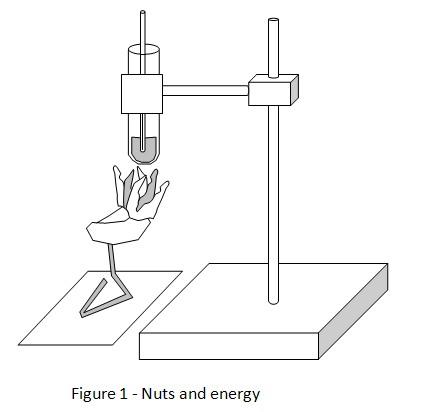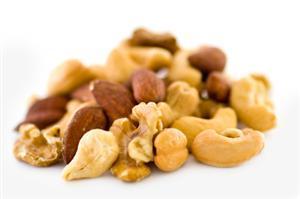| Complexity level: | 7 |
| Project cost ($): | 10 |
| Time required: | It will take an hour to set up the science experiment, and an hour to conduct it |
| Material availability: | The materials required can be purchased at a supermarket. |
| Safety concerns: | Ensure that you handle the lighter with care. Adult assistance is required. Conduct the experiment in a safe, properly equipped laboratory. |
Hypothesis
The first hypothesis is that nuts are able to store energy. Our second hypothesis is that the cashew nut will have a higher energy storage capacity than the peanut.
Overview
Nuts
Normally, a nut has a hard outer shell that shelters the edible inner part. This inner part is essentially a seed which is edible. Nuts are a rich source of protein. Unlike carbohydrates, proteins do not supply us with sharp and quick bursts of energy. Instead, it provides a slow but long lasting supply of energy.
Different types of nuts provide different kinds of nutritional benefits. Almonds, for example, contain many proteins. They are also rich in iron and potassium. Cashew nuts contain many kinds of amino acids, and copper. Walnuts contain many kinds of Omega-3 fatty acids. These acids serve as a source of energy for our organs and muscles.
Nuts can be eaten raw. They can also be roasted or cooked alongside other dishes. Nuts contain certain kinds of oils, and these can be extracted to make cooking oil or for other uses, including manufacturing of cosmetics. Wild animals depend on nuts for food. Animals such as squirrels collect nuts during autumn, storing them away for winter.
Scientific Terms
Materials
The materials required for this science fair project are as follows:
- a packet of peanuts
- a packet of cashew nuts
- 2 paper clips
- a lighter
- a pin
- a measuring cylinder
- 2 test tubes
- 200g of water
- a digital weighing machine
- a stopwatch
- a thermometer
Procedure
1. For this science fair project, the independent variable is the type of nuts used. In this science project experiment, the nuts are heated. The first dependent variableis the temperature of the water. The temperature is measured using a thermometer. Weigh the nuts, using a weighing machine, after they are heated. This weight is the second dependent variable. The constants (control variables) are the amount of water used, and the length of time for which the nuts were allowed to burn.
2. A peanut and a cashew nut are selected. A small hole is made on each nut using a pin. In procedure 3, mount the nuts on paper clips through the hole. The nuts are weighed and this measurement is recorded.
3. 2 paper clips are bent, as shown in figure 1 below, and the nuts are mounted on them.

4. A test tube is filled with 100g of water and mounted on a stand, as shown in figure 1. The base of the test tube should be 5mm above the peanut. The temperature of the water is measured using the thermometer.
5. The peanut is set on fire using a lighter. Once it starts burning, it is placed below the test tube and allowed to burn for 1 minute. After 1 minute, the fire is extinguished and the temperature of the water is measured.
6. If there has been an increase in the temperature of the water, calculate this and record it in the table below.
7. The peanut's weight is recorded in the table below.
8. Procedures number 4, 5, 6 and 7 are repeated with the cashew nut.

Results
The nuts contained energy. The cashew nut stored a higher amount of energy than the peanut.
|
Initial weight (g) |
Weight after burning (g) |
Difference in weight (g) |
Temperature increase (°C) |
Calories used in burning |
Calories per gram |
|
|
0.78 |
0.29 |
0.49 |
2.5 |
250 |
510 |
|
|
Cashew nut |
1.30 |
0.78 |
0.52 |
3.0 |
300 |
576 |
Calories used = Weight of water (g) x temperature rise of the water (°C)
Calories per gram = Calories used / Lost Weight (g)
Conclusion
The hypothesis holds true- the nuts contained energy. The cashew nut had a higher energy storage capacity than the peanut.
We should consider eating nuts instead of drinking coffee or soft drinks when we feel tired. Like such drinks, nuts are able to give us energy. However, they are a healthier alternative than coffee or soft drinks and in fact, are as tasty as other snacks.
Also consider
Use different types of nuts such as almonds, hazelnuts, walnuts and pistachios.
Using 200g of water instead. Compare the results of the new experiment with the results of the current one.
References
Nut (fruit) - http://en.wikipedia.org/wiki/Nut_ (fruit)
Nuts to increase energy - http://www.workingwellness.com/fitness-&-excercise/nuts-to-increase-energy.php

